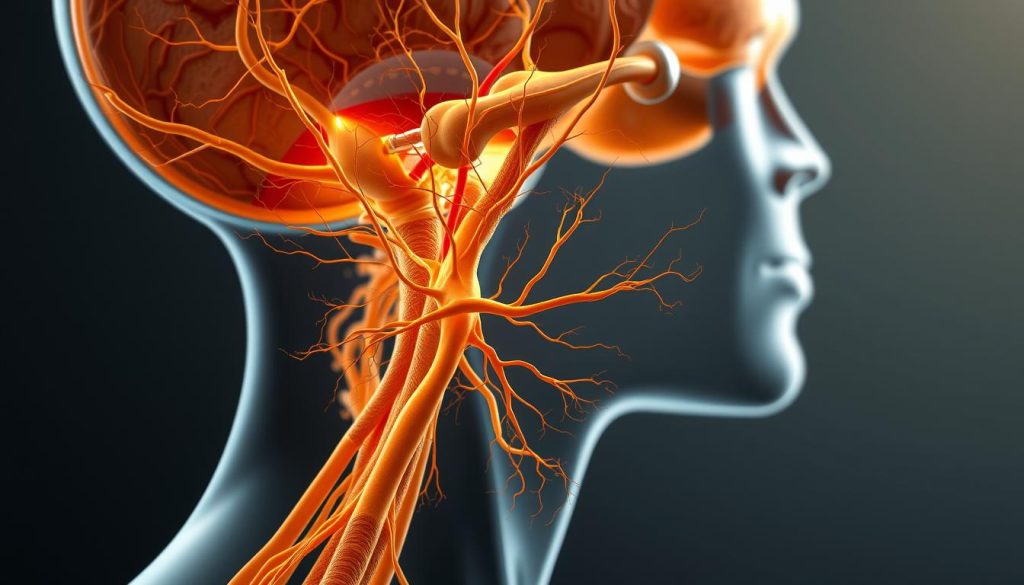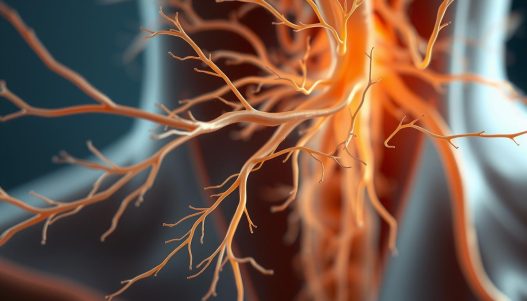Imagine a hidden pathway in your body that acts like a built-in stress-relief button. This isn’t science fiction—it’s the reality of your body’s longest cranial nerve, which stretches from your brainstem to your gut. Known for its role in calming your heart rate and aiding digestion, this nerve is now at the center of modern wellness breakthroughs.
In 2025, managing daily pressures has become a top priority. Research shows how constant stress impacts our health, making it crucial to find effective solutions. That’s where methods targeting this natural relaxation system shine. By gently activating it, you can shift your body from “fight-or-flight” mode to a calmer state almost instantly.
The FDA already approves devices using mild electrical pulses to treat conditions like epilepsy and migraines. But you don’t need complex tech to start—simple breathing exercises or cold exposure can kickstart its benefits. As scientists uncover more about this nerve-body connection, everyday people are discovering practical ways to harness its power.
Key Takeaways
- Your body’s longest cranial nerve plays a key role in relaxation and digestion
- Modern stress demands innovative solutions backed by research
- FDA-approved devices show promising results for specific health conditions
- Simple techniques like deep breathing can activate this natural system
- Understanding this nerve helps you take control of stress responses
Introduction to Vagus Nerve Stimulation and Stress Relief
2025 has unveiled a groundbreaking approach to wellness rooted in our nervous system. What began as clinical research now offers millions natural solutions for modern anxieties. This biological toolkit works by activating your body’s innate relaxation pathways, creating ripple effects from brain function to emotional balance.
From Labs to Living Rooms
Traditional stress management often treats symptoms, not causes. Recent studies reveal how everyday actions—like humming a tune or pausing for mindful breaths—can trigger healing responses. “These methods don’t just calm you temporarily—they reshape how your body handles pressure,” notes a Johns Hopkins neuroscientist.
Three key factors drive this shift:
- Digital overload disrupting natural rhythms
- Increased awareness of stress-related health risks
- Demand for accessible self-care tools
The 2025 Stress Landscape
Our world now combines environmental challenges with pandemic-era mental fatigue. Research links chronic tension to weakened immunity and accelerated aging. Simple practices like cold showers or focused breathing sessions help many regain control—no apps or subscriptions required.
This approach particularly resonates with those seeking science-backed yet natural solutions. As one yoga instructor explains, “People want strategies that fit seamlessly into chaotic days while delivering real results.”
Understanding the Vagus Nerve and Its Impact on Health
Ever wonder how your body shifts from panic to peace? A remarkable biological network acts like an internal thermostat, constantly adjusting your stress levels. This system’s star player is a winding nerve connecting your brain to vital organs—a key architect of calm.
Anatomy and Function of Your Body’s Superhighway
This nerve begins at your brainstem, traveling down your neck and branching into your chest and abdomen. It’s like a telephone line linking your thought center to your heart, lungs, and gut. Every heartbeat and digestive gurgle gets regulated through these connections.
Researchers discovered it influences heart rate variability—a marker of resilience. When active, it helps maintain steady breathing patterns and efficient nutrient absorption. Think of it as your body’s quality control manager for physical and mental performance.
Balancing Act: Calm vs. Crisis Modes
Your nervous system has two main settings. The “action” mode prepares you for challenges—pupils dilate, muscles tense. The “recovery” mode, driven by your parasympathetic network, does the opposite. It lowers blood pressure and activates healing processes.
Chronic stress weakens this balance. A well-toned nerve, however, acts like a circuit breaker against inflammation. Studies show it can reduce inflammatory markers linked to arthritis, heart disease, and memory issues. As one immunologist notes, “It’s not just about feeling relaxed—it’s about cellular repair.”
Vagus Nerve Stimulation: The Science Behind 2025’s Hottest Stress-Relief Trend
Medical breakthroughs are revealing surprising ways to help your brain heal itself. A recent clinical trial made headlines when every participant with severe PTSD saw their symptoms vanish for six months after combining talk therapy with targeted nerve activation.

Scientific Research and Breakthroughs
Researchers at The University of Texas achieved what many thought impossible. Their nine-person study paired intense therapy sessions with gentle electrical pulses delivered through a tiny neck implant. “The results stunned us—no remaining PTSD diagnoses,” shared the lead scientist. This approach appears to supercharge the brain’s natural rewiring process.
How does it work? The pulses act like a biological amplifier during therapy. They help lock in new, healthier thought patterns. Patients reported feeling calmer faster, with effects lasting months after treatment ended.
Clinical Studies and FDA-Approved Applications
You might already benefit from this science without knowing it. FDA-cleared devices help manage epilepsy and migraines using similar technology. One implant model measures smaller than a quarter, yet delivers years of reliable support.
Rehabilitation specialists are now testing these tools for stroke recovery. When paired with physical therapy, they help patients regain movement 30% faster according to early data. As one neurologist noted, “We’re not just treating symptoms—we’re upgrading how the body heals.”
Holistic Approaches and Techniques for Nerve Stimulation
Your body holds surprising keys to tranquility that don’t require expensive treatments or complicated routines. Modern science confirms what ancient traditions knew—calmness lives in everyday actions. Let’s explore how timeless practices and smart tools work together to help you thrive.

Natural Methods: Deep Breathing, Meditation, and More
Start with your breath. Deep breathing triggers an instant relaxation response by activating your body’s calming network. Try this: inhale for four counts, hold for seven, exhale for eight. Repeat three times. Feel your shoulders drop?
Meditation offers similar benefits. Just 10 minutes daily can strengthen your body’s natural stress defenses. Studies show regular practice improves heart rhythm patterns and gut function. “It’s like upgrading your internal software,” shares a mindfulness coach.
Other accessible methods include:
- Humming or chanting to vibrate throat muscles
- Cold face splashes to jumpstart relaxation
- Social laughter that naturally engages the calming system
Innovative Devices and Their Role in Modern Wellness
For those seeking faster results, devices like TruVaga deliver precise stimulation. These palm-sized tools use gentle pulses to enhance your body’s natural rhythms. Most users notice calmer moods within days.
Wellness tech bridges ancient wisdom and modern needs. As inventor Joseph Peter Errico explains, “Consistent activation creates lasting changes—like daily workouts for your nervous system.” Many combine morning meditation with evening device sessions for full-spectrum care.
Key advantages of tech-enhanced methods:
- Measurable improvements in heart rate variability
- Reduced inflammation markers within weeks
- Portable designs for office or travel use
Future Directions and Research Innovations in VNS
The next wave of wellness breakthroughs is emerging from laboratories to living rooms. Scientists are unlocking how our body’s natural wiring interacts with cutting-edge tech to reshape health outcomes. Three revolutionary developments stand out: smarter devices, brain adaptability enhancements, and immune system optimization.
Emerging Therapies and Neuroplasticity
Your brain’s ability to rewire itself—neuroplasticity—gets supercharged through targeted activation. Recent trials show stroke patients regain movement 47% faster when combining physical therapy with precise stimulation. This approach helps create new neural pathways where damage occurred.
| Approach | Time to Improvement | Success Rate |
|---|---|---|
| Traditional Rehab | 6-12 months | 62% |
| VNS-Enhanced Rehab | 3-6 months | 89% |
| Home Device Programs | Daily Use | 74% |
Devices now fit discreetly behind the ear, with models 50x smaller than 2022 versions. “We’re not just repairing brains—we’re upgrading their operating systems,” explains Dr. Lena Marquez from Stanford’s NeuroInnovation Lab.
Potential Benefits for Mental and Physical Health
Your body’s chemical balance holds exciting possibilities. Studies confirm these methods boost serotonin production while lowering cortisol by 38% in chronic stress cases. The real game-changer? How this tech interacts with your immune defenses.
Key developments include:
- Autoimmune condition trials showing reduced inflammation markers
- Wearables that adjust stimulation based on real-time stress signals
- Combination therapies with meditation apps for 360° wellness
Researchers now explore applications beyond medicine—think enhanced focus for students or faster recovery for athletes. As one MIT team discovered, “Optimizing this system could add healthy years to human lifespans.”
Conclusion
Empowering your body’s innate healing mechanisms could revolutionize your health journey. Modern research reveals how activating specific biological pathways creates ripple effects across physical and mental well-being. This approach isn’t just innovative—it’s rooted in our fundamental physiology.
Your body’s natural relaxation network acts as a built-in stress manager. By engaging this system, you influence heart rate patterns, inflammation levels, and emotional resilience. Simple practices like extended exhales or cold therapy offer immediate benefits. For those seeking advanced support, wearable tech delivers precise activation—proving effective in recent clinical trials.
Groundbreaking studies show remarkable outcomes, including complete symptom resolution in PTSD patients when combining traditional therapy with targeted stimulation. As scientists develop smarter devices and deeper insights, these tools become more accessible. What once required medical implants now fits in your wellness routine.
Whether through morning meditation or evening tech sessions, optimizing this biological superhighway helps you reclaim calm in chaotic times. The path to balanced living starts with understanding your body’s hidden potential.






